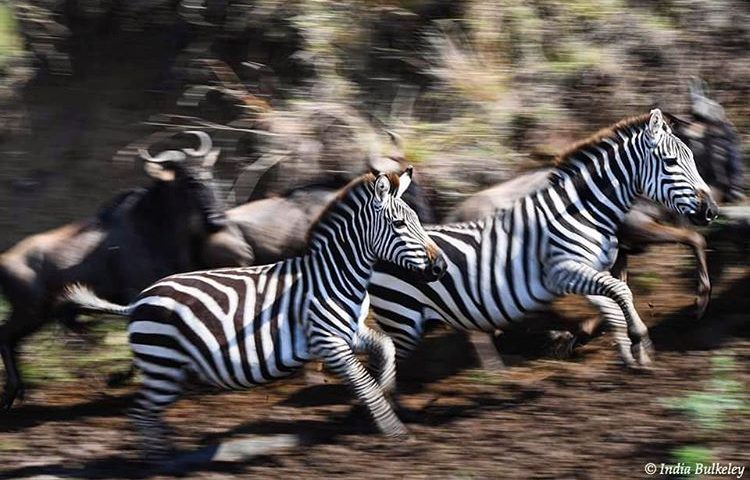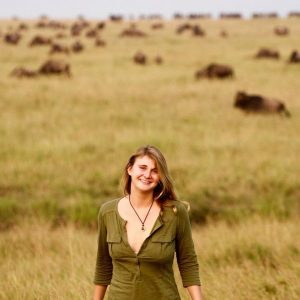Wildlife Photographer India Bulkeley Is Living the Wild Life



India Bulkeley followed her passion.
Now she is a wildlife photographer living in Kenya, seeking nature’s most candid moments and working the best job in the world. Behind the scenes, she is building her social media following along with her artistic confidence.
India is in Kenya. No, your geography knowledge isn’t wrong. Wildlife photographer and Naibor Camp Manager India Bulkeley is living in Africa to follow her passion, hone her trade, bring awareness to animal endangerment and experience the world of wildlife up close and personal. Packing up and moving across the world after graduating from the University of Southern California, India is indulging her wanderlust and her commitment to become a wildlife photographer in a beautiful place provides unforgettable lessons and moments. While generously sharing her experience living abroad as a wildlife photographer with me, India also offered some advice for aspiring photographers.
Samantha Jacobs: Can you explain where you work right now, and what your job is?
India Bulkeley: I have the best job in the world. I work as a manager at Naibor, a tented camp in the heart of the Masai Mara Reserve in Kenya. As manager, I do a little bit of everything including leading a staff of 30+ people, hosting guests, and completing general office work. I’m lucky I get to wake up every day and do what I love. Living in such a beautiful place has let me follow my passion: photography. In my spare time, I’m trying to grow my portfolio with the hopes of making it a primary career in the future.
https://www.instagram.com/p/BRn-OmiDeGe/?taken-by=indiabulkeley
SJ: When did your passion for photography start? And what about your passion for wildlife?
IB: I’ve loved being behind a camera since I was a kid. I found photography to be a great way to gain a new look at your surroundings and explore new places. My favorite subjects are people, but it was in the last two years that I realized my passion for wildlife. This passion grew mostly from living in such close proximity to amazing reserves and parks in Kenya. It’s a privilege to live in a place which is considered one of the premier wildlife destinations in the world. I can leave my home and be photographing lions, elephants, gazelles, etc. in a matter of minutes. Photographing wildlife is incredibly challenging and can thus be very rewarding. It’s a combination of luck and skill and no two shots are ever the same.
“I hope that my work introduces people to animals and places that they don’t know a lot about. I have plans to use my photography to draw light on the extinction crisis facing many animals today such as elephants, rhinos, and cheetahs.”
SJ: Why and when did you decide to move to Africa?
IB: When I graduated from college, I received a one-year fellowship to do communications work for a nonprofit in Kenya, the BOMA Project. I spent a lot of time traveling in Northern Kenya interviewing (and photographing) participants in the program and falling in love with the country. In college I spent a semester abroad at the University of Cape Town and worked in Rwanda for a summer with opportunities to travel a bit in Southern and Eastern Africa. I returned home curious about other countries and parts of the continent. Kenya is a great place to live especially for people interested in wildlife, photography, and a great quality of life.

SJ: Describe a typical day at work.
IB: I usually wake up and start work between 6:30 and 7:30 every day. I’m lucky that the commute between my home and office is about a 3-minute walk. I start by seeing guests off on their morning game drives and then doing paperwork, emails, etc. for the bulk of the morning. The afternoons are usually a bit quieter. I get to go on a game drive about once (twice if I’m lucky) a week depending on how busy we are. In the evenings, I host dinners and head to bed around 10 pm.
“It’s a combination of luck and skill and no two shots are ever the same.”
SJ: How does social media affect your job?
IB: Social media has been a really big part of getting my photos and name out there. I’ve been able to connect with photographers around the world and have been approached by many people interested in my photos. It’s also been a good way to do easy publicity for my camp. Pictures are a great marketing tool and nowadays a lot of people pick their holidays based on photos they’ve seen of places they’d like to go.
SJ: What are some ways in which you try to grow your professional social media following?
IB: I originally started with Instagram because it’s a platform I’m used to and really all about the photos. In order to gain more followers, I engage with other users who like wildlife or wildlife photography I’ve found that most people that follow me and regularly like my pictures are also photographers or have been on safari before. I’ve also recently begun using Facebook as a platform to tell the stories of my photos in greater detail.
SJ: How do you avoid cliches in your photography? How do you make your photos unique?
IB: I’ve found that following the “rules” of photography is generally a good idea but with lots of exceptions. One of the rules of photography is to shoot with the light behind you, not in front of you. One of my favorite angles, however, is shooting into the sun in the early mornings or evenings when the light isn’t too strong. I love silhouette shots and playing around with light to give different effects. You can have a completely different picture of the same animal if you just change your angle. I am also a big fan of “panning” shots, something that makes my photos unique. Panning captures a moving animal in focus while the background is blurred. I like these shots because they are challenging and, if executed well, capture a beautiful sense of movement.
SJ: Do you feel you have a greater purpose connected to your work?
IB: Since I live in the same place I work and photograph, I definitely feel a greater connection to nature and the environment. I hope that my work introduces people to animals and places that they don’t know a lot about. I have plans to use my photography to draw light on the extinction crisis facing many animals today such as elephants, rhinos, and cheetahs. People react to images and stories so I think there are many ways to help conservation efforts through using those as tools. One of my big goals for the next two years is to have an exhibit with a portion of the proceeds going to conservation work.
SJ: What is the coolest thing you’ve seen on the job?
IB: Living in the Masai Mara for the past year, I’ve seen a lot of amazing things. One of the coolest was watching lions try to take down a very large hippo in the middle of the savannah. It was crazy to see lions jumping on a creature with skin more than an inch thick and playing with it like it was a toy. Luckily the lions got tired after a while and the hippo lived to see another day. Other than that, I find the little things are pretty spectacular. I love watching sunsets from across the plains, seeing animals huddle together during big storms, and hearing the river flowing from my desk.
SJ: What are some lessons you’ve learned from working?
IB: The most important lesson I’ve learned is to always be ready. There are many times where I’ve missed the shot I wanted because I didn’t have my camera ready or was distracted. You can’t really tell a lion to go back and do that yawn again because you weren’t ready. Now I try to always keep my camera on standby and with the correct settings. Another important lesson I’ve learned is that patience pays off. Some of the best pictures I’ve taken are the product of waiting (sometimes for minutes, sometimes for hours) for an animal to wake up, for the light to change, etc.

SJ: Do you have any advice for aspiring photographers? And in particular, for aspiring photographers with an adventurous side and a bit of wanderlust?
IB: It may sound cliche, but fake it until you make it. Since photography is not yet my primary job, I felt self-conscious about calling myself a photographer. I recently started introducing myself a wildlife photographer and its done wonders for confidence. Doing things like creating a website and establishing a social media presence are great ways to get your foot in the door. For people who have a bit of a travel bug, marketing yourself online is a huge asset. One of my goals is to be able to use my social influence to help me travel to other parts of the world photographing wildlife.
“Start building your portfolio and find ways to travel. If international travel isn’t yet in your budget, visit national parks that are close by, go on a hike, or spend a day exploring and photographing your town. It’s amazing how much beauty you can find in your own backyard so take advantage of it!”
